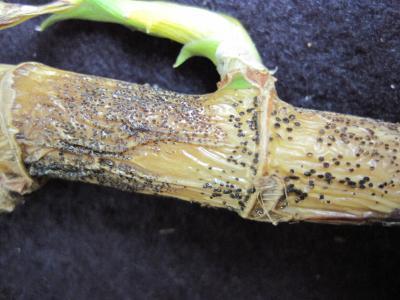GAINESVILLE, FL – The popularity of ornamental plants imported to the United States from China is accompanied by concerns about the potential to introduce pathogens into the market. Dracaena, a genus consisting of approximately 40 different species, including the widely recognized "lucky bamboo," is among the most frequently imported group of ornamentals to enter the U.S. for domestic sale and eventual export to Canada. The authors of a new research study say it is crucial to be vigilant about potential pests and pathogens on imported cuttings of Dracaena. "Pests and pathogens currently not in the United States could be imported with Dracaena plant materials," said Ariena H.C. van Bruggen, corresponding author of the study published in HortScience. Lucky bamboo (Dracaena sanderiana) with anthracnose symptoms was first found in Florida in 2009; the infection was associated with the fungus Colletotrichum dracaenophilum, a pathogen that originated in Asia.
The researchers evaluated the effects of hot water treatments on symptomless lucky bamboo planting material and tested fungicides for the control of Colletotrichum in asymptomatic, but infected, rooted cuttings as well as inoculated plants.
"The most important finding of our study was that the hot water treatments tested were not promising for the control of C. dracaenophilum latently present in lucky bamboo as plants become more susceptible at higher temperatures," the researchers said. The team also determined that seemingly healthy rooted cuttings of lucky bamboo introduced from China may carry C. dracaenophilum, which can induce anthracnose symptoms several months after arrival in the United States. "It is not known which environmental factors may trigger the appearance of symptom. However, in this study, lesions appeared on noninoculated stalks when irrigation intervals were lengthened. Thus, water stress may trigger the induction of symptoms," the authors said.

Researchers determined that hot water treatments were not promising for the control of C. dracaenophilum latently present in lucky bamboo. They recommended a systemic approach to controlling the pervasive fungal infection.
(Photo Credit: Photo by Kalpana Sharma.)
Remarkably, analyses showed that 25% to 43% of noninoculated lucky bamboo stalks included in the study contained the latent presence of Colletotrichum dracaenophilum. The authors determined that traditional hot water treatments such as those tested in the study were "not promising" for controlling the latent fungus, but noted that other temperature-time combinations could be tested in future studies. Application of the systemic fungicide Azoxystrobin was found to be effective both at preventing new infections by C. dracaenophilum and curing latent infections and anthracnose development on lucky bamboo plants.
The authors recommended implementation of a systems approach to address the problem, including: training and disease management at the source, careful inspection of plants at ports of entry, fungicide treatment of rooted cuttings to eliminate latent infection, and training and disease management in nurseries at lucky bamboo's destinations.